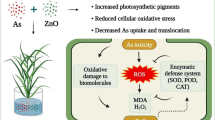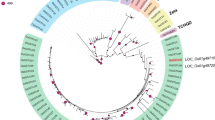Abstract
Paddy rice trends to accumulate more arsenic (As) from soils than other terrestrial crops. The toxicity and mobility of As mainly depend on its chemical species. Transformation of arsenite [As(III)] into arsenate [As(V)] would be a promising method to mitigate As toxicity. In the current study, As(III)-oxidizing strain SMS11 isolated from As-contaminated soils was employed for As remediation. Co-cultured with SMS11 alleviated As(III) stress to the rice plants by increasing the length and biomass of rice shoots up to 10% and 15%, respectively. Evaluation of oxidative stress indices showed that the activity of catalase in the rice shoots was weakened when exposed to As(III), increasing the risk of hydroxyl radical (·OH) formation. When co-cultivated with the bacteria, ·OH formation was significantly inhibited in the rice shoots. The ionomes of the rice plants were impacted by the external conditions. As(III) stress significantly disturbed ionome homeostasis in the rice plants. Uptake of As simultaneously elevated the levels of macro and nutrient elements such as Mg, P, K, Ca, and Zn in the rice shoots. The ionomic variation in the rice plants under As(III) stress was mitigated by inoculated with SMS11. The results represented that the As(III)-oxidizing bacteria alleviated external As(III) stress to the rice plants through elevating antioxidative activities and modulating ionome homeostasis.





Similar content being viewed by others
Availability of Data and Materials
All data generated or analyzed during this study are included in this published article and its supplementary information files.
References
Stone R (2008) Food safety—arsenic and paddy rice: a neglected cancer risk? Science 321:184–185
Dong YM, Bao QL, Gao ML, Qiu WW, Song ZG (2022) A novel mechanism study of microplastic and As co-contamination on indica rice (Oryza sativa L.). J Hazard Mater 421:126694
Zhao F-J, Wang P (2019) Arsenic and cadmium accumulation in rice and mitigation strategies. Plant Soil 446:1–21
Du F, Yang Z, Liu P, Wang L (2018) Accumulation, translocation, and assessment of heavy metals in the soil-rice systems near a mine-impacted region. Environ Sci Pollut Res Int 25:32221–32230
Baah DS, Gikunoo E, Foli G, Arthur EK, Entsie P (2021) Health risk assessment of trace metals in selected food crops at Abuakwa South Municipal, Ghana. Environ Monit Assess. https://doi.org/10.1007/s10661-021-09373-8
Song Y, Zhang F, Li H, Qiu B, Gao Y, Cui D, Yang Z (2020) Antioxidant defense system in lettuces tissues upon various As species exposure. J Hazard Mater 399:123003
Giral M, Zagury GJ, Deschenes L, Blouin JP (2010) Comparison of four extraction procedures to assess arsenate and arsenite species in contaminated soils. Environ Pollut 158:1890–1898
Sun J, Ma L, Yang Z, Lee H, Wang L (2015) Speciation and determination of bioavailable arsenic species in soil samples by one-step solvent extraction and high-performance liquid chromatography with inductively coupled plasma mass spectrometry. J Sep Sci 38:943–950
Ma L, Wang L, Jia Y, Yang Z (2016) Arsenic speciation in locally grown rice grains from Hunan Province, China: spatial distribution and potential health risk. Sci Total Environ 557–558:438–444
Rehman MU, Khan R, Khan A, Qamar W, Arafah A, Ahmad A, Ahmad A, Akhter R, Rinklebe J, Ahmad P (2021) Fate of arsenic in living systems: implications for sustainable and safe food chains. J Hazard Mater 417:126050
Du F, Yang Z, Liu P, Wang L (2019) Bioaccessibility and variation of arsenic species in polished rice grains by an in vitro physiologically based extraction test method. Food Chem 293:1–7
Lomax C, Liu W-J, Wu L, Xue K, Xiong J, Zhou J, McGrath SP, Meharg AA, Miller AJ, Zhao F-J (2012) Methylated arsenic species in plants originate from soil microorganisms. New Phytol 193:665–672
Du F, Liu P, Wang K, Yang Z, Wang L (2019) Influence of different arsenic species on uptake, speciation and efflux of arsenic in hydroponic rice plants. Ecotoxicol Environ Saf 186:109791
Cao Y, Sun D, Ai H, Mei H, Liu X, Sun S, Xu G, Liu Y, Chen Y, Ma LQ (2017) Knocking out OsPT4 gene decreases arsenate uptake by rice plants and inorganic arsenic accumulation in rice grains. Environ Sci Technol 51:12131–12138
Zhao FJ, Ma JF, Meharg AA, McGrath SP (2009) Arsenic uptake and metabolism in plants. New Phytol 181:777–794
Ma JF, Tamai K, Yamaji N, Mitani N, Konishi S, Katsuhara M, Ishiguro M, Murata Y, Yano M (2006) A silicon transporter in rice. Nature 440:688–691
Ma JF, Yamaji N, Mitani N, Tamai K, Konishi S, Fujiwara T, Katsuhara M, Yano M (2007) An efflux transporter of silicon in rice. Nature 448:209–212
Yu H-Y, Ding X, Li F, Wang X, Zhang S, Yi J, Liu C, Xu X, Wang Q (2016) The availabilities of arsenic and cadmium in rice paddy fields from a mining area: the role of soil extractable and plant silicon. Environ Pollut 215:258–265
Hussain MM, Bibi I, Niazi NK, Shahid M, Iqbal J, Shakoor MB, Ahmad A, Shah NS, Bhattacharya P, Mao K, Bundschuh J, Ok YS, Zhang H (2021) Arsenic biogeochemical cycling in paddy soil–rice system: interaction with various factors, amendments and mineral nutrients. Sci Total Environ 773:145040
Punshon T, Jackson BP, Meharg AA, Warczack T, Scheckel K, Guerinot ML (2017) Understanding arsenic dynamics in agronomic systems to predict and prevent uptake by crop plants. Sci Total Environ 581–582:209–220
Upadhyay MK, Yadav P, Shukla A, Srivastava S (2018) Utilizing the potential of microorganisms for managing arsenic contamination: a feasible and sustainable approach. Front Environ Sci. https://doi.org/10.3389/fenvs.2018.00024
Xiao W, He X, Lin G, Yang Z, Wang L (2021) Arsenite-oxidizing bacteria isolated from an abandoned realgar mining area: characterization and the influence on arsenic accumulation in rice seedlings. Environ Technol Innov 23:101800
Wang K, Li Y, Wu Y, Qiu Z, Ding Z, Wang X, Chen W, Wang R, Fu F, Rensing C, Yang G (2020) Improved grain yield and lowered arsenic accumulation in rice plants by inoculation with arsenite-oxidizing Achromobacter xylosoxidans GD03. Ecotoxicol Environ Saf 206:111229
Thongnok S, Siripornadulsil W, Siripornadulsil S (2018) Mitigation of arsenic toxicity and accumulation in hydroponically grown rice seedlings by co-inoculation with arsenite-oxidizing and cadmium-tolerant bacteria. Ecotoxicol Environ Saf 162:591–602
Yang G-D, Xie W-Y, Zhu X, Huang Y, Yang X-J, Qiu Z-Q, Lv Z-M, Wang W-N, Lin W-X (2015) Effect of arsenite-oxidizing bacterium B. laterosporus on arsenite toxicity and arsenic translocation in rice seedlings. Ecotoxicol Environ Saf 120:7–12
Baxter I, Dilkes BP (2012) Elemental profiles reflect plant adaptations to the environment. Science 336:1661–1663
Xiao W, Liu P, Wang K, Yang Z, Wang L (2021) Relationship between ionomics and transcriptomics of rice plant in response to arsenite stress. Environ Exp Bot 189:104565
Du F, Liu P, Wang K, Yang Z, Wang L (2020) Ionomic responses of rice plants to the stresses of different arsenic species in hydroponics. Chemosphere 243:125398
Yoshida S, Forno DA, Cock JH, Gomez KA (1976) Laboratory manual for physiological studies of rice, 3rd ed. Los Baños, Philippines, 83 pp
Chen S, Jiang J, Long T, Zhu X, Zhang H, Deng S, Liu R (2021) Oxidative stress induced in rice suspension cells exposed to microcystin-LR at environmentally relevant concentrations. Environ Sci Pollut Res 28:38393–38405
Li B, Zhang T, Yang Z (2019) Immobilizing unicellular microalga on pellet-forming filamentous fungus: can this provide new insights into the remediation of arsenic from contaminated water? Biores Technol 284:231–239
Ma L, Wang L, Jia Y, Yang Z (2017) Accumulation, translocation and conversion of six arsenic species in rice plants grown near a mine impacted city. Chemosphere 183:44–52
Ma L, Yang Z, Tang J, Wang L (2016) Simultaneous separation and determination of six arsenic species in rice by anion-exchange chromatography with inductively coupled plasma mass spectrometry. J Sep Sci 39:2105–2113
Wang X, Sun W, Zhang S, Sharifan H, Ma X (2018) Elucidating the effects of cerium oxide nanoparticles and zinc oxide nanoparticles on arsenic uptake and speciation in rice (Oryza sativa) in a hydroponic system. Environ Sci Technol 52:10040–10047
Xu J, Shi S, Wang L, Tang Z, Lv T, Zhu X, Ding X, Wang Y, Zhao F-J (2017) OsHAC4 is critical for arsenate tolerance and regulates arsenic accumulation in rice. New Phytol 215:1090–1101
Thongnok S, Siripornadulsil W, Siripornadulsil S (2021) AsIII-oxidizing and Cd-tolerant plant growth-promoting bacteria synergistically reduce arsenic translocation, toxicity and accumulation in KDML105 rice. Environ Exp Bot 192:104660
Wituszyńska W, Karpiński S (2013) Programmed cell death as a response to high light, UV and drought stress in plants. In: Vahdati K (ed) Abiotic stress—plant responses and applications in agriculture. IntechOpen, Rijeka, pp 207–246
Cuypers A, Hendrix S, Amaral dos Reis R, De Smet S, Deckers J, Gielen H, Jozefczak M, Loix C, Vercampt H, Vangronsveld J, Keunen E (2016) Hydrogen peroxide, signaling in disguise during metal phytotoxicity. Front Plant Sci 7:470
Dumanović J, Nepovimova E, Natić M, Kuča K, Jaćević V (2021) The significance of reactive oxygen species and antioxidant defense system in plants: a concise overview. Front Plant Sci 11:552969–552969
Lin G, Ma L, He X, Tang J, Wang L (2023) Gene regulation and ionome homeostasis in rice plants in response to arsenite stress: potential connection between transcriptomics and ionomics. Biometals. https://doi.org/10.1007/s10534-023-00510-z
Wang X, Peng B, Tan C, Ma L, Rathinasabapathi B (2015) Recent advances in arsenic bioavailability, transport, and speciation in rice. Environ Sci Pollut Res 22:5742–5750
Acknowledgements
This work was financially supported by the National Natural Science Foundation of China (No. 41977351) and the Natural Science Foundation of Hunan Province, China (No. 2021JJ31094).
Funding
This work was financially supported by the National Natural Science Foundation of China (No. 41977351) and the Natural Science Foundation of Hunan Province, China (No. 2021JJ31094).
Author information
Authors and Affiliations
Contributions
Conceptualization: LW, JT; Formal analysis: GL; Investigation: GL, JZ; Validation: QW; Visualization: GL; Resources: QW, LW; Writing—Original draft: LW, GL, JT; Supervision: LW; Funding acquisition: LW, JT; Writing—Review and Editing: QW.
Corresponding author
Ethics declarations
Competing interests
The authors declare that they have no competing interests.
Ethics Approval and Consent to Participate
Not applicable.
Consent for Publication
Not applicable.
Additional information
Publisher's Note
Springer Nature remains neutral with regard to jurisdictional claims in published maps and institutional affiliations.
Supplementary Information
Below is the link to the electronic supplementary material.
Rights and permissions
Springer Nature or its licensor (e.g. a society or other partner) holds exclusive rights to this article under a publishing agreement with the author(s) or other rightsholder(s); author self-archiving of the accepted manuscript version of this article is solely governed by the terms of such publishing agreement and applicable law.
About this article
Cite this article
Wang, Q., Lin, G., Zeng, J. et al. As(III)-Oxidizing Bacteria Alleviate Arsenite Toxicity via Reducing As Accumulation, Elevating Antioxidative Activities and Modulating Ionome in Rice (Oryza sativa L.). Curr Microbiol 80, 320 (2023). https://doi.org/10.1007/s00284-023-03434-6
Received:
Accepted:
Published:
DOI: https://doi.org/10.1007/s00284-023-03434-6




